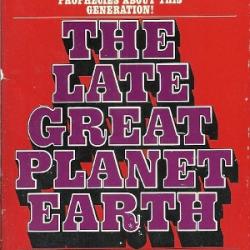Tribulation Force, pp. 388-391
We readers — along with Buck, Rayford, Nicolae and apparently the entire world — are watching Rabbi Tsion Ben-Judah present the findings of his three-year, Israeli-government sponsored research project on the Messiah.
Rabbi Ben-Judah said he and his team spent almost the entire first year of their project confirming the accuracy of the late Alfred Edersheim, a teacher of languages and Grinfield Lecturer on the Septuagint. Edersheim had postulated that there were 456 messianic passages in Scripture, supported by more than 558 references from the most ancient rabbinical writings.
Here’s where alarm bells would sound, Ben-Judah’s microphone would be cut off and the broadcast would end as the rabbi was bustled off to have to explain his behavior. Alfred Edersheim was a Jewish convert to Christianity.
There’d be no reason for Tsion and his research assistants to begin with Edersheim unless they were determined to end up where Edersheim did — as converts. For him to begin his broadcast by announcing that he began his research here is as clear a signal as there could be of the conclusions he was seeking. The authors want Ben-Judah’s final declaration — that Jesus is the Messiah — to be a secret surprise ending to the broadcast, but Tsion has already let the cat out of the bag. He may as well be speaking in front of a giant “Jews for Jesus” banner at this point.
This curious choice of how to spend the first year of his project also undermines the author’s claims that Ben-Judah was simply a disinterested scholar, following the texts to their inevitable conclusion. That conclusion was apparently his starting point. He chose to begin not with the Hebrew scriptures, but with the writings of a Christian whose expertise was in the Greek translation of those scriptures. That’s two steps removed from the primary sources he was commissioned to study, and a very curious two steps at that.
Please note that I’m not disparaging Edersheim — I’m sure he deserves better than the abuse and misuse of having his name invoked this way here in Tribulation Force. I’m simply pointing out that spending a year studying a Christian scholar of Greek is a very strange choice for the first step in this project.
“Now,” the rabbi said, “I promise to not bore you with statistics …”
And then, as warned, he proceeds to bore his viewers with statistics.
“… but let me just say that many of those prophetic passages are repetitive and some are obscure. But based on our careful study, we believe that there are at least 109 separate and distinct prophecies Messiah must fulfill. …”
Here he departs from Edersheim in two ways. First by taking Edersheim’s category of “passages … applied to the Messiah or to Messianic times” and reformulating that into “distinct prophecies.” The former description is much broader than the narrowly predictive, fortune-teller notion of “prophecy” to which Ben-Judah (and Tim LaHaye) subscribes. It tends to apply to the question of “How ought we to live?” as opposed to the less pressing question of “What is it that we’re someday in the future expecting to happen?”
The second departure is the interesting step of reducing that list of 456 passages down to only 109. This is only partly to eliminate repetition. It’s also a convenient way of dismissing all those passages and rabbinic writings that can’t be made to point in the direction Ben-Judah and LaHaye want them to point. (You can read Edersheim’s list here, if you’re interested.)
“We consulted a mathematician and asked him to calculate the probability of even 20 of the 109 prophecies being fulfilled in one man. He came up with odds of one in one quadrillion, one hundred and twenty-five trillion!”
You may recognize this trick from Ken Hamm and other young-earth creationists. There’s probably a formal name for it, but I think of it as the Buckaroo Banzai Fallacy (“wherever you go, there you are”). It’s a bit of misdirection in which one hand showily displays a Very Large Number, expressed as odds, while the other hand begs the question. Ben-Judah inadvertently follows up with an illustration of why his quadrillion-to-1 odds is actually meaningless.
Dr. Ben-Judah gave what Rayford considered a brilliant example of how to easily identify someone with just a few marks. “Despite the billions of people who still populate this planet, you can put a postcard in the mail with just a few distinctions on it, and I will be the only person to receive it. You eliminate much of the world when you send it to Israel. You narrow it more when it comes to Jerusalem. You cut the potential recipients to a tiny fraction when it goes to a certain street, a certain number, a certain apartment. And then, with my first and last name on it, you have singled me out of billions. That, I believe, is what these prophecies of Messiah do. They eliminate, eliminate, eliminate, until only one person could ever fulfill them.”
That, in short, seems to have been Ben-Judah’s approach to the study of these “prophecies” — eliminate, eliminate, eliminate whatever doesn’t address the one person he’s looking to identify.
If we were to employ the same mathematician Ben-Judah hired, we could prove how astonishingly unlikely it is that I could be sitting here, at this computer, writing this post. There are billions of galaxies, each containing billions of stars. The odds against me being right here, of all places, are already literally astronomical before we even “eliminate” all the non-earth locations in which I might have been instead. Then we come to this particular ball of rock, with its 7 billion inhabitants, nearly 200 countries, 50 states in this country, 67 counties in this state, dozens of towns in this county, dozens of streets in this town, dozens of homes on this street.
Multiply that all together and you can come up with a staggeringly huge figure that we could cite either to prove that I couldn’t possibly really be sitting here or else that my sitting here is a remarkable, miraculous, super special event.
The vastly implausible odds we could invoke might even sound impressive enough to make one forget that the starting point for all those calculations was a given — that we were, all along, working backwards from the conclusion and begging the question.
Rayford Steele finds this argument dazzling:
Dr. Ben-Judah was so engaging that everyone on the plane had stopped talking, moving, even shifting in their seats. Even Nicolae Carpathia … barely moved.
Rayford realizes that they are scheduled to land before the end of the broadcast, but he doesn’t want to miss the ending and he wants to make sure the others don’t miss it either, so he ducks back into the cockpit, briefly, to instruct his first officer (the guy actually flying the plane while Rayford watches TV):
“I want this plane to not touch the ground before five minutes after the hour. … Make whatever adjustments you have to make.”
… Rayford gave him the thumbs-up and hurried back to the television.
After reading Rayford’s gushing praise for Ben-Judah’s broadcast, readers may be wondering if Buck Williams is also awestruck. Jerry Jenkins flashes back to the GIRAT to assure us that, yes, he is. Everyone is awestruck by the rabbi:
Buck prayed as he watched. Other staffers had gathered around monitors. There was none of the usual behind-the-scenes banter. People were glued to the broadcast. …
Ben-Judah’s broadcast, apparently, is almost as absorbing and fascinating as someone listing the countries of the world alphabetically in nine languages.
“Messiah is not limited to just a few identifying marks,” Ben-Judah said. “We Jews have been looking for him, praying for him, longing for him for centuries, and yet we have stopped studying the many identification hallmarks in our Scriptures. …
And here we realize that it wouldn’t have mattered if Ben-Judah had begun his study with the actual scriptures rather than with the writings of a Christian expert on their Greek translation. Not when this is Ben-Judah’s notion of what all that scripture says about the Messiah boils down to: “identification hallmarks.”
His next statement suggests a glimmer of some larger idea:
“And yet the prophecies themselves tell us what Messiah will do. Let us examine just a few of them in the remaining time.”
But he never follows through on this promise. None of the “prophecies” that he cites have anything to say about “what Messiah will do.” They’re all, instead, about “identification hallmarks” — proper lineage, birthplace, etc. And those hallmarks really do seem to constitute the whole of Ben-Judah’s understanding of Messiah.
What will Messiah do? What is Messiah for? Ben-Judah doesn’t know how to answer that question. He doesn’t seem to know how to even ask that question. Pressed for an answer, he would say something like, “The Messiah will come in order to fulfill the 109 messianic prophecies by meeting all of the prophesied identification hallmarks.”
For Ben-Judah, all that matters about the Messiah is his c.v. and whether it contains all 109 of those “hallmarks.” This is not how any of the prophets spoke of the Messiah or the messianic age. Their concern, above all else, was what the Messiah will do. There was thus one and only one hallmark that really mattered to them when it came to identifying the Messiah: the Messiah is the one who acts as the Messiah.
Tsion Ben-Judah doesn’t seem to have any idea of what that would mean.
Ben-Judah’s long study seeking the hallmarks of the Messiah parallels Tim LaHaye’s even longer study seeking the identification hallmarks of the Antichrist. Each of them in their respective quests has gotten sidetracked by peripheral questions, with each constructing long check lists by which they can evaluate and eliminate prospective candidates. Each getting so obsessed with the listing of such criteria that they completely lose sight of whatever it was that this Christ or Antichrist was supposed to be about in the first place.












